In my article about visiting the Labyrinth of a Thousand Illusions, I wrote that our trip on the Nangaritza River was worthy of its own post. Well, here it is. It’s not Tom and Huck’s trip down the Mississippi River, but it was interesting.
Not Your Average Nangaritza River Trip
We’ve traveled in motor canoes before. For example, we’ve spent hours on the Cuyabeno River in Northern Ecuador. However, this was our first experience with a metal-hulled rather than fiberglass canoe. The first thing that struck me was how big they were, more than twenty feet long by five feet wide. It was like walking on to a small commuter airplane with two uncomfortable seats on each side and a very narrow center aisle. The only things missing were the tray tables. Of course, the fact that the whole canoe wobbled from side to side and that there was no cabin made the experience very different.
The day of our trip, the Nangaritza River was high and running fast. I wouldn’t want to be the person going overboard into these choppy, brown waters. While the life vest would keep me afloat, I would be way downriver before these big boats could turn around. Not to mention the fact that there were no ladders up to the sides of these canoes. The only way to get back in after falling out is to pull oneself over the three foot high sides.
The narrowest point of the river, called the Miazi Canyon, is only about twenty feet wide. You might think that all this water squeezed into a super narrow space would be the fastest part of the river. It was just the opposite, a place smooth as glass without an obvious current. You would never imagine that the same river would be two hundred feet wide and raging another mile up river. This gorge must be super deep for the water to be so tranquil in this section.

An Unpleasant Surprise
After floating through a tranquil and wild space, I was unpleasantly surprised to find a the number of gold mining sites on the other end. I had expected to enter an even denser and wilder section of the river.
These were not artisanal mines. However, according to our guide and driver for the day, Carlos, many locals make good money from re-working the tailings. These mines are capital-intensive, requiring industrial work. Oddly enough, for all of this dirt moving, we didn’t see any processing plants nor lines of trucks moving the material out of the area.

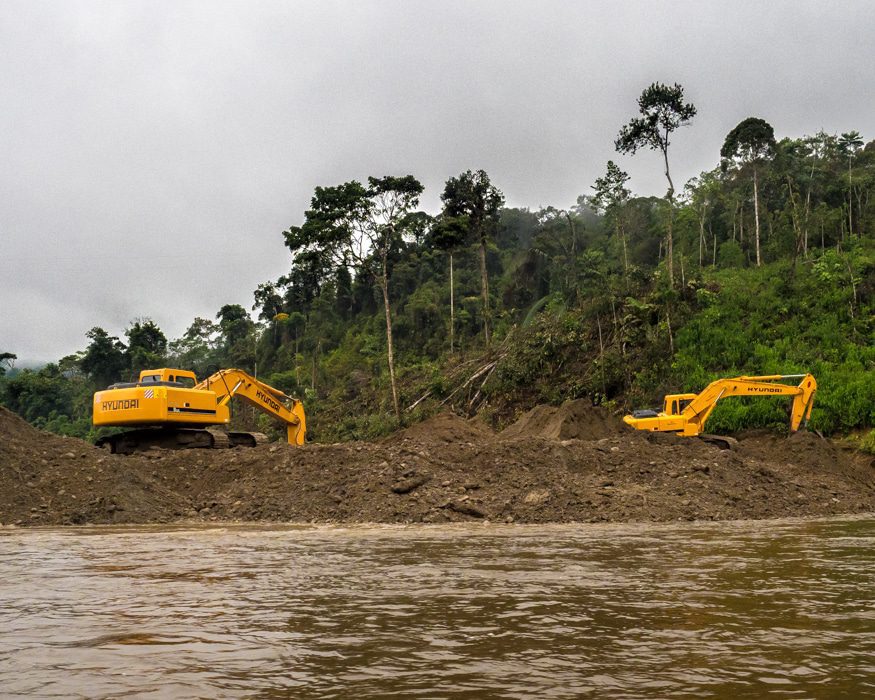
A busy river with a changing face
It was also apparent from the river that this was not a particularly remote place, at least by the local definition. We saw a couple of small communities and many people using the river as a highway or road, just completing their day-to-day activities. I guess we weren’t the only people who thought the road through the jungle wasn’t the easiest way to get around.
It may be difficult to see in these photos, but the color of the river made a stark change after we passed the confluence with the Shaime River. It went from a near glacial grey to deep black. The color change is so stark that you can even see it from space!
There must be an incredible amount of minerals in the Shaime to change the color so dramatically given its smaller volume of water. Conversely, the amount of vegetable material required to give the Nangaritza its dark color is truly awesome. I don’t remember ever seeing such a dark river in any of my travels.

Continuing upstream, it was like we were on another river completely. Not only was the color of the water different, the river channel was wider, the water like a calm mirror-image. At this point on the trip, we started to see birds! Two highlights: the pre-historic looking Hoatzin and the hard-to-see Cocoi Heron.
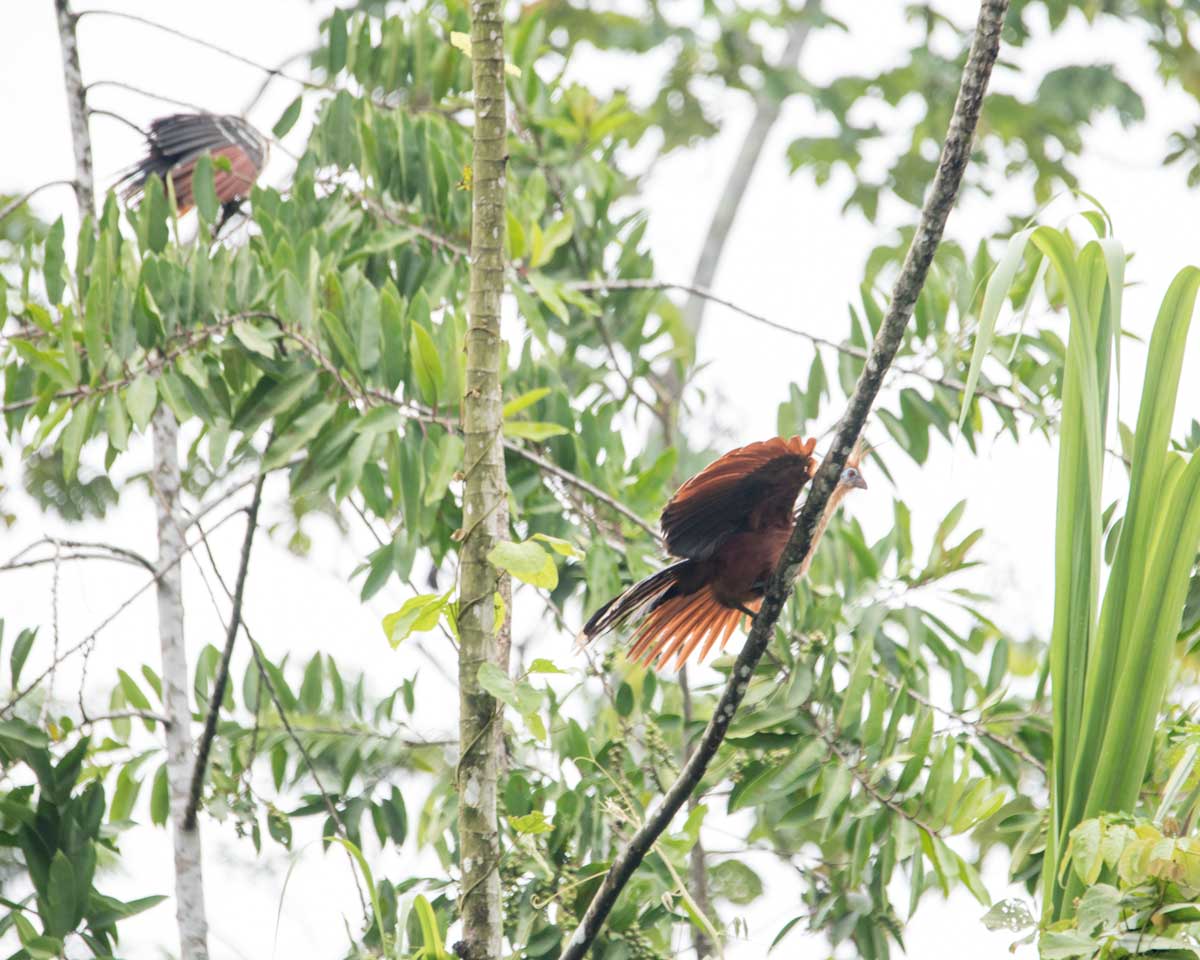

After about a half hour of shimmering black water, we arrived at the mooring (a small tree) for the Labyrinth of a Thousand Illusions. Our experience there was excellent, if muddy.
Read About Our Hike to the Labyrinth
The Journey Back
Just as we finished our hike, the rain started coming down as only seen in the jungle… sheets of it. We were sitting under a corrugated steel roof at the trailhead when it started. We had to stop talking because of the noise! After about 20 minutes, despite the pouring rain, we decided to head back to the boat for the return trip. The trail down to the boat was a river all its own. A pretty little cascade near where the boat was tied had turned into a chocolate brown waterfall.
After bailing out the canoe (it’s shocking how much water can collect in a big canoe), we untied, pushed off and started floating downriver. Carlos pulled on the outboard starting line… and pulled… and pulled… and pulled to no effect. So we paddled back to the shore and I hung on to an overhanging tree while Carlos troubleshot the engine.
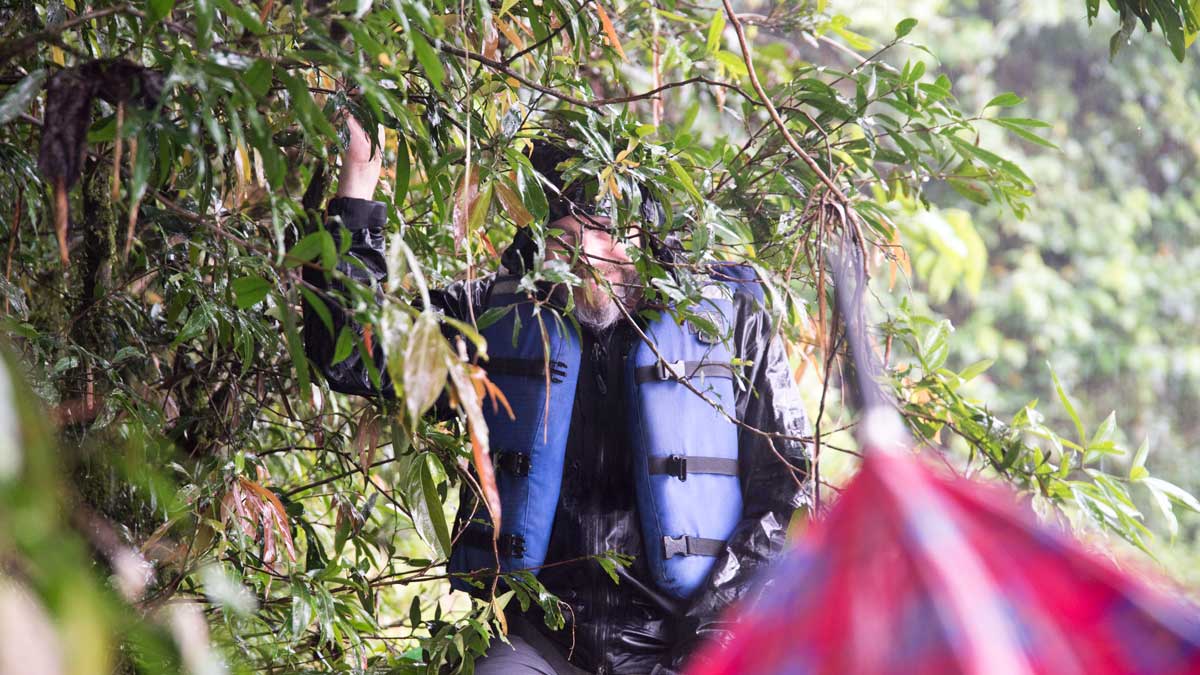
A Leisurely Float
It was obvious that Carlos had experience with engine trouble. He jumped right in to the problem. He took the top of the motor off, removed the spark plugs and checked that they were clean and dry. Then he rewound the starter cord. After every step, Carlos gave a mighty effort to start the engine. We actually got some really hopeful coughs and sputters but the engine failed to catch. Eventually, Carlos told us we’d have to push off and float down to the first village. There was a tool he needed and he was sure he could get it there.
So we pushed off into the black water and drifted downstream. It had taken us more than half an hour to motor up to this spot, so we got comfortable for a long ride. At least the rain had slowed by this time. While we weren’t characters in the “Heart of Darkness” or anything, we did run a check of our available trail mix and water after Carlos told us a story about how he was once stranded on the river for twelve hours before another boat came along.
Some Rocky Times on the Nangaritza
Carlos didn’t seem comfortable using the eight-foot-long paddle to guide the canoe. Fortunately, the river was running really slow for the first twenty minutes or so. Then we came around a bend and saw rapids up ahead. I hadn’t even noticed them coming upriver, but it’s a little different experience when you don’t have a motor. Carlos didn’t want anything to do with them, so he paddled and I poled the canoe away from the rapids to a calmer part of the river. As we moved, I noticed the fist-sized rocks at the bottom of the river. I also noticed the rocks seemed to be moving closer and closer to the surface. In moments, we found ourselves aground in a couple of feet of fast-moving water.
Unfortunately, we found ourselves in the classic “forward or back” question familiar to anyone who has ever found themselves lost or stranded. A stretch of (apparently) deeper water was yards ahead, but we couldn’t tell how deep or if the water between us and it would support the canoe without grounding out yet again. What we did know was that the three of us weren’t going to be carrying this heavy, metal canoe any distance whatsoever.
It Gets Worse Before It Gets Better
After a moment, Carlos decided to back the canoe off the rocks and go thru the rapids. Now, while backing a twenty-foot long metal canoe off a shoal may sound easy, I can tell you it definitely is not.
After I snapped the pole and Carlos couldn’t move the canoe with the paddle, I hopped out and started pushing. That didn’t go well either, so it was all hands in the river for a maximum effort. Angie jumped in too. The combination of all our pushing and an empty canoe worked to get the canoe off the rocks and floating again. We walked it back against the current into deeper and deeper water. Angie hopped back in, Carlos hopped back in, and I was left in chest deep water (sometimes it’s hard to be the tallest of the group) trying to keep the canoe out of the sunken trees along the shore as Carlos got himself organized.
You may remember reading above about how difficult it would be to get back in the canoe if you fell out. I can tell you those comments come from hard experience. I really have to hand it to Angie, she didn’t laugh once (at least that I heard) as I pushed, pulled and cursed myself back into the canoe. I’m also grateful we were so wet she didn’t think to pull her camera out. While I’m sure that clip would have gotten many views and comments, I’m really glad I don’t have to live down the laughter. On the bright side, I don’t think our boots have ever been cleaner and we really didn’t care if it rained anymore because we certainly couldn’t get any wetter.
Saved By A Water Taxi
After all that, our transit of the rapids was anti-climatic and we continued floating down the river as our clothes slowly dripped dry. Fortunately, the water and air temperatures were warm enough that hypothermia wasn’t a threat.
Fast forward an hour and we’re still drifting down the river. Finally, we hear and then see another boat coming towards us, its loud buzzing engine drowning out all other sounds. It was one of the water taxis that ply up and down the Nangaritza.
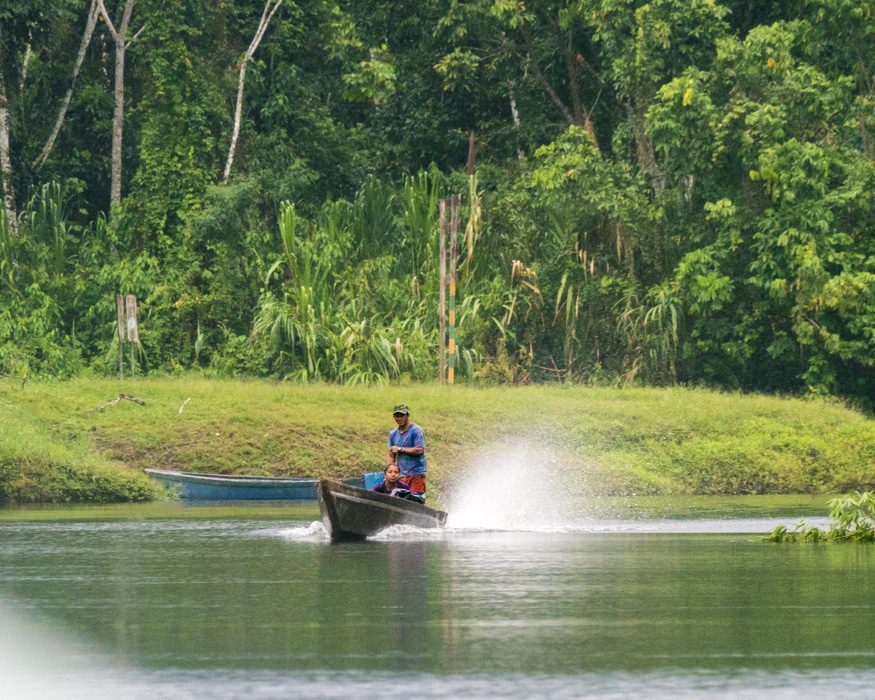
Fortunately for us, the driver pulled over and tied up to our canoe. It didn’t take us long to learn that Jesus and Anna were heading back up river after a day of sifting thru the mining tailings I talked about above. Once Carlos described our problem, Jesus jumped over and took his turn at the engine. After half an hour or so, Carlos and Jesus came to the realization that we really needed the tool that Carlos didn’t have in his bag. So Jesus took off down river to see if the “engine repair guy” in the next village had it.
Jesus returned with the tool and, miraculously, Carlos was able to get the engine started! What a relief.
We immediately took off down river… and then stopped at the first village. We needed gas. I have to admit to some concern when Carlos came back and tried to start the engine. Fortunately, it worked and we were on our way. The rest of the trip back to the lodge was, thankfully, uneventful.
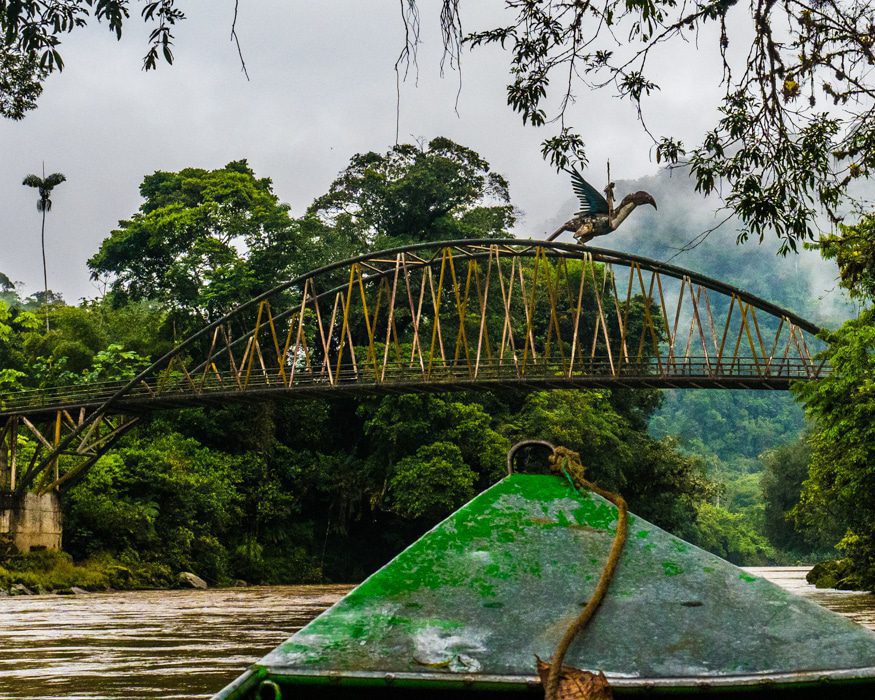
All’s well that ends well
We arrived at the small pier, sopping wet, very tired, and just more than a little hungry. But what an adventurous day!
The next afternoon, Carlos told us that the problem had been caused by a torn gasket. It allowed too much gasoline to enter the carburetor, causing the engine to flood. In fact, this problem should have prevented the engine from running at all. He couldn’t explain why the engine managed to start again. Guess we’ll just chalk it up to good travel karma!

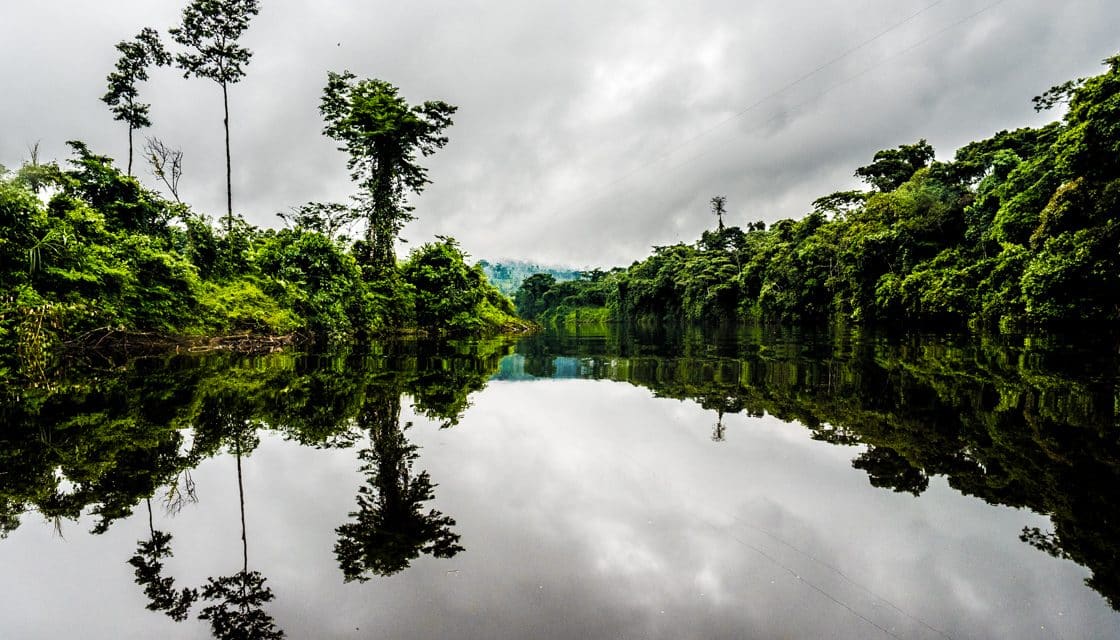



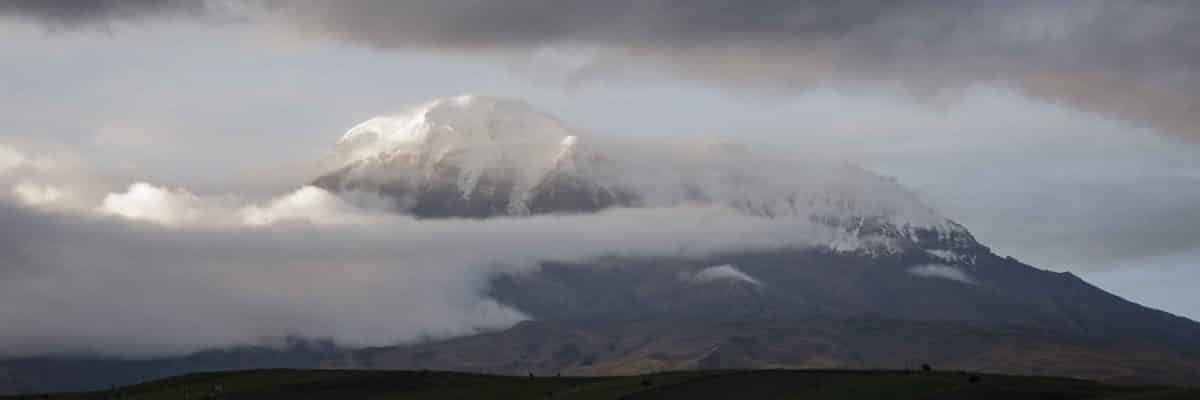
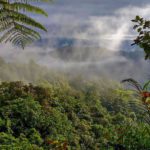
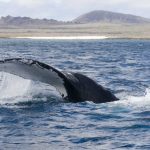
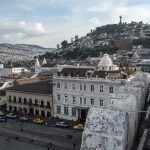
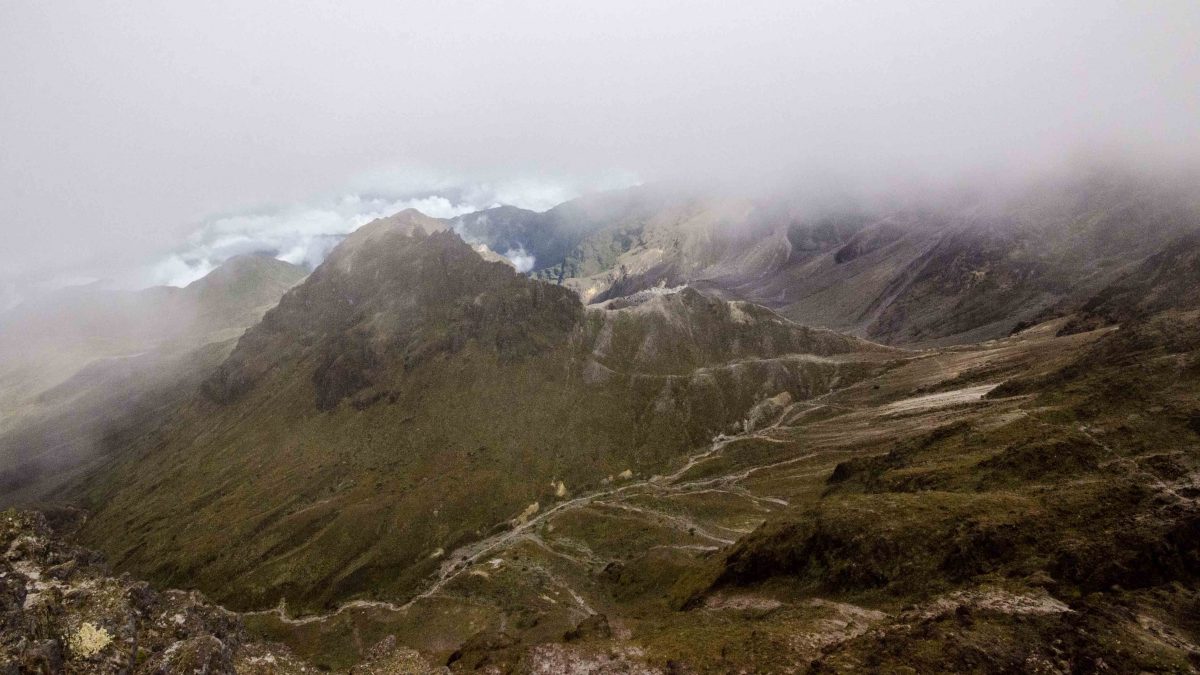
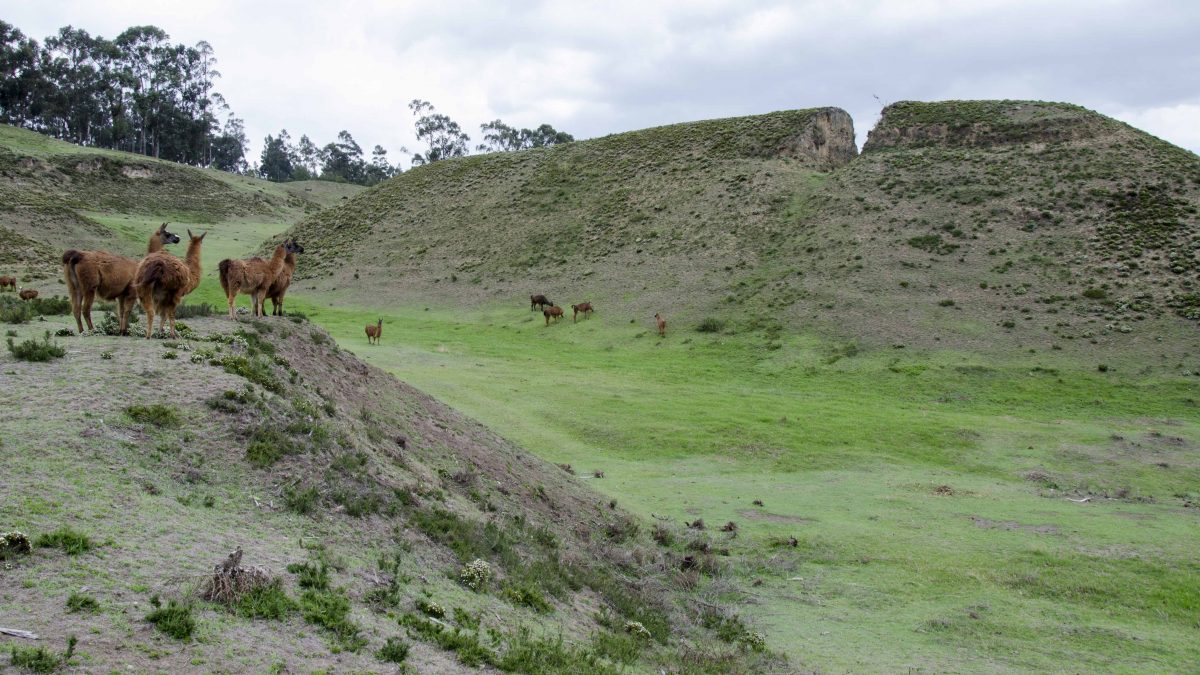





Que buen articulo, sin embargo el rió negro no es por la explotación si no que naturalmente ya es así es algo raro de la naturaleza.
y si, es lamentable ver que el rió nangaritza este invadida de minerías que opaca el contraste de la naturaleza que el ALTO NANGARITZA TIENE..
Gracias por el artículo Éxitos.
Gracias por tu comentario! En inglés, la palabra mineral no significa solamente minerales de extraccion. Tambien, significa minerales naturales que proviene desde la tierra. Sabemos que el color oscuro y muy negro del Rio Negro es natural – Sin embargo, entiendo por qué es confuso la forma en que está escrito. Editaremos el artículo para indicar claramente que los minerales de la vegetación en descomposición son responsables del rico color!